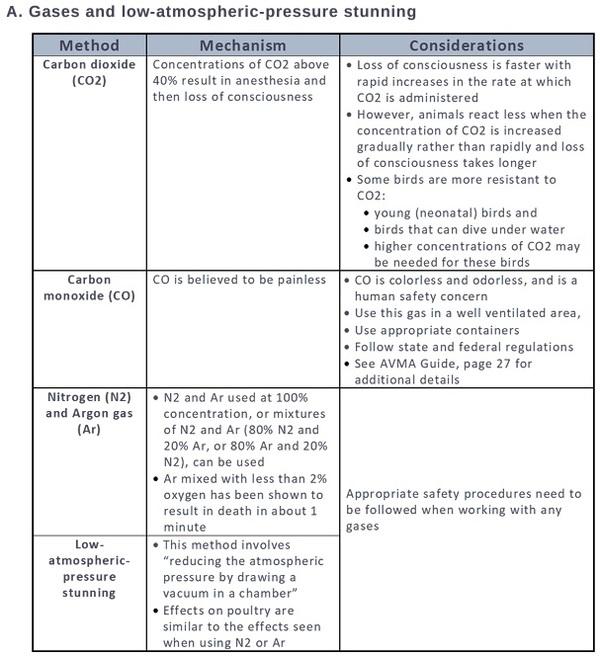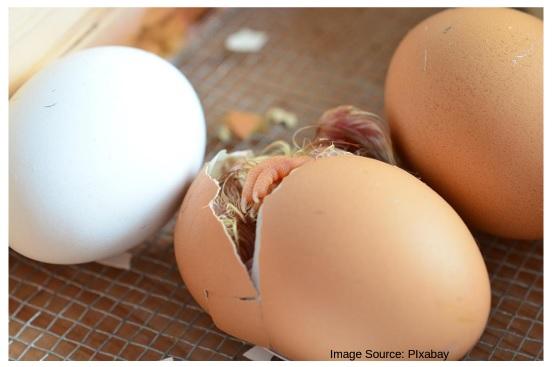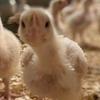On-farm euthanasia methods for poultry


- Acceptable under certain circumstances,
- Are associated with higher chances of error and risks to personnel safety, or
- There is not much scientific research available to examine how effective these methods are.
- How to: see HSA(a) and Boyal et al. 2020a




- Anesthetic overdose
- Decapitation
- Carbon dioxide exposure for more than 20 minutes
- Carbon dioxide exposure for more than 20 minutes
- Cooling at a temperature of less than 4°C for 4 hours
- Freezing
AVMA guidelines for the euthanasia of animals https://www.avma.org/sites/default/files/202002/Guidelines-on-Euthanasia-2020.pdf Boyal et al., 2020a. Single bird CO2 system. https://www.aces.edu/blog/topics/farming/poultryeuthanasia-single-bird-carbon-dioxide-system/ The Alabama Cooperative Extension System. Boyal, et al. 2020b. Poultry Euthanasia: Koechner Euthanizing Device. https://www.aces.edu/blog/topics/farming/poultry-euthanasia-koechner-euthanizing-device/ The Alabama Cooperative Extension System. Boyal, et al. 2020c. Poultry Euthanasia: Electrical Euthanasia Device. https://www.aces.edu/blog/topics/farming/poultry-euthanasia-electrical-euthanasia-device/ The Alabama Cooperative Extension System. Canadian Food Inspection Agency. 2019. Guidelines for stunning techniques for avian food animals, including ratites. https://inspection.canada.ca/food-safety-for-industry/food-specificrequirements-and-guidance/meat-products-and-food-animals/guidelines-for-stunningtechniques/eng/1538160892409/1538160892704 Canadian Poultry Industry Council. 2016. Practical guidelines for on-farm euthanasia of poultry. https://www.poultryindustrycouncil.ca/downloads/practical-guidelines-for-on-farm-euthanasia-ofpoultry.pdf Humane Slaughter Association (a). Gaseous methods. https://www.hsa.org.uk/gaseousmethods/gaseous-methods Humane Slaughter Association (b). Cervical dislocation and decapitation. https://www.hsa.org.uk/stunning-and-killing-poultry-using-electricity/cervical-dislocation-anddecapitation-manual-and-mechanical Humane Slaughter Association (c). Stunning poultry using electricity followed by a killing method. https://www.hsa.org.uk/stunning-and-killing-poultry-using-electricity/stunning-poultry-usingelectricity-followed-by-a-killing-method Humane Slaughter Association (d). Non-penetrating captive bolt. https://www.hsa.org.uk/mechanical-methods-poultry/non-penetrative-captive-bolt Humane Slaughter Association (e). Chicks (less than 72 hours old) and embryonated eggs. https://www.hsa.org.uk/chicks-less-than-72-hours-old-and-embryonated-eggs/chicks-less-than-72hours-old-and-embryonated-eggs Jacob, J. and Martin, G. 2022. Poultry end-of-life situations in small and backyard flocks. https://poultry.extension.org/articles/poultry-management/poutry-end-of-life-situations-in-smalland-backyard-flocks/ Jacobs et al., 2019. Manual and mechanical cervical dislocation. https://www.pubs.ext.vt.edu/content/dam/pubs_ext_vt_edu/APSC/apsc-161/APSC-161.pdf












.jpg&w=3840&q=75)